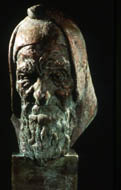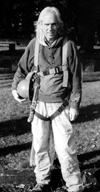
Home » Community » Legacy Members » Boris Spivak

Remembering Our Teacher, Mentor, Friend Boris Spivak 1938-2007
Boris immigrated to the USA in November 1980. He talked to us about it at one of the early Symposia. Not knowing English, he worked here first as a janitor, and the self-portraits that he painted at the time, show someone almost invisible. How do you start a new life? How do you communicate who you are and what you are worth? How do you balance being an artist with supporting a family in a new country?
Looking at Boris’ sculptures, the immediacy of his psychological and existential processes come out to grab us. One of these sculptures is called “Sins,” or “Despair.” It is in roughly carved marble of a naked man clutching his head in his hands; his agony is heart-wrenching. Boris used sculptures to communicate his experiences, as well as his ideas and philosophical search (see for example “My Generation.”).He did a lot of commissioned work, portraits and life size groups (“The Fathers of Issaquah”), and he tried his hand at more decorative pieces, but it is his humanism and the honesty of observation that make some of his more personal sculptures truly great art. It was coupled with an incessant devotion to Sculpture — the skills, the methods, the processes. Brought up in art in the Russian tradition, he was adamant to his students that they should study drawing first, then clay, then stone.
Rich Hestekind fondly tells the story of Boris laughing at himself when obsessively having to carve a rough stone into a block before he could begin carving the sculpture.
He was born in the former Soviet Union, and grew up in Lvov, the cultural center of the Ukraine. After receiving a degree in mechanical engineering at the prestigious Ivan Fedorov College of Printing, he began advanced study at the Studio of Fine Arts and Graphic Design in Lvov and at the Atelier for Industrial Arts and Graphic Design in Kharkov, USSR. He was later invited to teach at the Ivan Fedorov College of Printing, where he remained while working on a PhD thesis.
Then he brought his family with him to start a new life in the United States. Though he felt invisible at first and struggled to find the recognition that he deserved, he surely made his mark as an artist.
He was a member of NWSSA for several years.

He also taught at the Frye Art Museum, The Seattle Academy of Fine Arts, (now Gage Academy of Art) and in his studio.
Boris was a great teacher. He taught patiently and not so patiently, always with humor, always with encouragement, always inspiringly, and with an untiring desire to share his knowledge of anatomy and get into the very mathematics of portraiture and bas relief. I was fortunate to be one of his students. It was easy to become fond of him; and to sense that whole world of other experiences and aesthetic sensibilities that he had left behind. It was easy to be awed and exasperated both by the expectation of perfected precision of skills, and it was tremendous to witness the devotion, the resolve, the love of art and the spirit that shines through it.
Boris lost his battle against cancer in January 2007. Our thanks go with him for all that he shared of himself.
Remembering Our Teacher, Mentor, Friend: Boris Spivak 1938-2007 – May/June 2007 Issue of Sculpture NorthWest by Tone Orvik





We need some kind of descriptive text here.